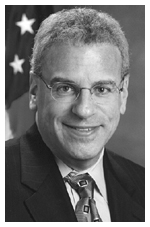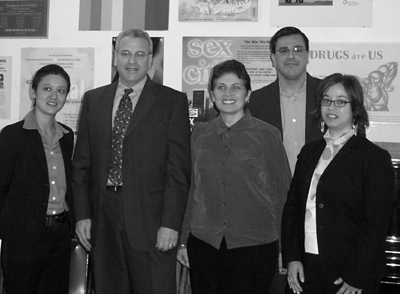|
Outlook for the 2006 Legislative Session
As the New Year begins, the Committee is already gearing up for the 2006 session. It is
expected that reform of the way Albany does business will continue, and that we will see
a permanent end to the legislative gridlock and late budgets that have plagued New York
for too long. Hopefully, when the Governor submits his last budget to the Legislature before
his retirement, he will finally get the message that addiction treatment works, and will
accordingly provide the level of funding that is needed to make sure that everyone who
needs treatment can get it. Under the leadership of Speaker Sheldon Silver, the Assembly
has time and again fought to make sure that the Governor’s budget cuts would not be allowed
to stand unchallenged, and that fight will be no different this year. The Assembly Committee
on Alcoholism and Drug Abuse will continue to be in the forefront of the state’s fight against
substance abuse.
As New York State expands gambling, there is little question that the number of persons needing
help with gambling problems will increase. Problem gambling is gambling behavior which causes
disruptions in major facets of life, including psychological, physical, social or vocational issues. The
term “problem gambling” includes, but is not limited to, the condition known as “pathological” or
“compulsive” gambling, an addiction characterized by increasing preoccupation with gambling, a
need to bet more money more frequently, restlessness or irritability when attempting to stop, and
loss of control by continuation of the gambling behavior in spite of mounting, serious, negative
consequences.
New York State has only recently begun to realize that problem gambling is a serious issue, and
the past few state budgets have reflected that realization as funding for treatment has increased.
A further step was taken in this year’s budget, which contained language that authorized the transfer
of power to develop and regulate plans, programs and services related to compulsive gambling
from the State Office of Mental Health (OMH) to the State Office of Alcoholism and Substance Abuse
Services (OASAS). Since OASAS is an agency which deals primarily with addiction, moving authority
over programs relating to gambling addiction from OMH to OASAS was an appropriate action that will
lay the groundwork for a renewed focus on compulsive gambling treatment.
This change has brought the issue of problem gambling squarely under the auspices of the
Alcoholism and Drug Abuse Committee, and Assemblyman Dinowitz plans to attack the problem
head-on in the upcoming session.
Among the important issues the Committee is developing is the Co-occurring Disorders Demonstration
Program. “Co-occurring disorders” or “dual diagnosis” refers to those who have been diagnosed with
major mental health disorders and alcohol or substance addictions at the same time. At least 50 percent
of the 2 million Americans with severe mental illness abuse illicit drugs or alcohol, compared to 15 percent
of the general population, according to the Alcohol, Drug Abuse, and Mental Health Administration. The
Committee recognizes that all New Yorkers who experience co-occurring mental and substance abuse
disorders must have an opportunity for effective treatment and recovery, and that systems of services must
evolve to reflect the growing evidence that promotes integrated treatment and supportive services. Both
disorders must be addressed as primary illnesses and treated as such in an integrated manner.
Assemblyman Dinowitz will introduce legislation to authorize a program to facilitate such integrated
treatment. The program would be established and implemented within existing, OASAS-licensed
chemical dependence treatment providers operating in six locations, with one site to be located within
each of the following six regions of New York state: New York City, Long Island, the Hudson Valley, North
Country, Central and Western New York. Program participants would be selected pursuant to a request
for proposal process. Assemblyman Dinowitz plans to take the fight to deal with the issue of co-occurring
disorders to the budget table, in hopes that the Governor and the State Senate will join the Assembly in
funding treatment programs.
Another initiative the Committee will be working on in 2006 is a Chemical Dependence Treatment Bill
of Rights. Assemblyman Dinowitz believes it is critical that persons taking the crucial step of getting into
treatment for drug or alcohol addiction should be treated with respect and dignity. This is essential if they
are to regain control of their lives and become productive members of society. Under the Bill of Rights
proposal the Committee is working on, any patient or client of a chemical dependence program, service
or treatment facility would be entitled to such rights as to participate in developing an individual plan of
treatment, receive an explanation of services in accordance with the treatment plan, participate voluntarily
in and to consent to treatment, and to object to, or terminate, treatment.
The Committee also hopes to explore the problem of addiction among New York State’s senior citizen
population. During the 2006 session, in conjunction with the Assembly Committee on Aging, the
Committee plans to hold hearings and meetings to learn more about the needs of the elderly when
it comes to addiction, especially alcoholism and compulsive gambling.
As in years past, the upcoming session will be a long and contentious one, but with your support the
Committee will continue to do all it can to improve the lives of citizens and communities both in the
Bronx and across New York State.
|

 Pictured (L to R) Georges Mathieu, Principal Rene Cassanova, Fernando Mañon,
Assemblyman Dinowitz, Teresa Goudie, Wilma White, Charles Ogundimu
Pictured (L to R) Georges Mathieu, Principal Rene Cassanova, Fernando Mañon,
Assemblyman Dinowitz, Teresa Goudie, Wilma White, Charles Ogundimu

